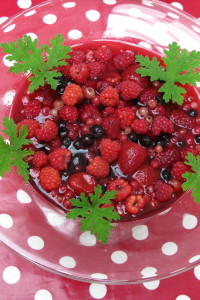At long last I’ve discovered the secret of how to give a totally stress free dinner party. Invite house guests who love to cook and want to cook for you and lots of your friends as a thank you for their stay. Bliss!
My friend Camilla Plum from Copenhagen and her lovely daughter Asta stayed with us recently, Camilla is both a gardener and a cook, in fact a very well-known one and the author of very many successful cook books. She also presents TV programme and cooking shows both on growing and cooking food, a subject on which she is deeply knowledgeable. They live on a small farm about 35 acres called Fuglebjerggaard about an hour north of Copenhagen. It’s an oasis of chic and cool, but more importantly it is a glowing example of the variety and biodiversity that can be produced on a small acerage, with about 200 food crops, orchards, many heirloom varieties of barley for homemade beer and wheat to dry and grind for sourdough bread which is then baked in the woodburning oven.
Camilla also has about 200 sheep; she saves the wool and cures the skins to make the sheepskin rugs we remember. Sadly, nowadays sheep’s wool is worth virtually nothing in this era of synthetic fibres that can be thrown into washing machine without ill effect but Camilla sometimes uses the wool as mulch for her vegetable crops. I’m really looking forward to trying that in the garden this year. She also saves seeds of a wide variety of heirloom vegetables, over 100 types of chilli alone and keen gardeners from far and wide seek her out to find rare and super flavourful food. www.fuglebjerggaard.dk
Back to the dinner party, Camilla and Asta raided the pantry and winter garden and spent the afternoon chopping and snipping and marinating….when I arrived in from the school, tantalizing smells pervaded the house, the fire was lighting, the table was laid, the candles were lit and there was a veritable feast for all of us to enjoy…can you imagine
Blood Orange and Scallion Salad, Salmon with Chermoula, Date and Green Raisin Chutney, Neck of lamb with Fennel and Yoghurt, Roast Potato wedges with lots of bayleaves, Cherry Tomato and Roasted Red Pepper Salad and a big bowl of green salad, Basmati Rice with Almonds and lots of Dill, followed by Apricots with Ginger, Avocado Cream with Dried Rose Petals, Prunes with Tea and Vanilla, Danish Red Berry Compote with Jersey Cream….
The food looked fresh and beautiful and tasted so summery in the midst of our depressing winter weather. Try some of these recipes for yourself.
Hot Tips
Creating a Soft Fruit Garden with Susan Turner
On Monday March 7th 2016, Susan Turner will teach an intensive half day course covering topics such as selecting fruit varieties, designing the fruit garden layout, looking at aspect spacing and plant training structures, creating fans, cordons and bushes with gooseberries, red currants, white currants……and much more. Coffee on arrival and light lunch included. www.cookingisfun.ie
Wine Tasting in the Grainstore at Ballymaloe
California Wines Tasting in The Grainstore at Ballymaloe House on Wednesday March 9th at 7pm. Tickets for the event are €10 and in-cludes talk, wine tasting and canapés.
Tel 021 4652531 or email colm@ballymaloe.ie
http://www.ballymaloegrainstore.com/portfolio/california-wines-less-more
Camilla’s Lamb with Fennel and Yoghurt
We use homemade Jersey yoghurt
Serves 8
7 lamb necks, each cut into 3 ‘chops’ – 3.2 kg
1 large onion, coarsely chopped
1 whole head of garlic, split in half horizontally
1½ tablespoon cumin seeds, slightly crushed
1½ tablespoons coriander seeds, slightly crushed
800 ml (27 fl oz) pots of homemade natural yoghurt
7 fennel bulbs, quartered
4 tablespoons extra virgin olive oil
Zest of 3 lemons
Salt
Garnish
Fresh spinach or chard
Toasted whole almonds
100 g (3½ oz) fennel fronds
Lots of fresh mint
In two roasting tins, mix the lamb chops with the chopped onion, garlic and spices. Marinate the lamb necks in the spices, lemon zest and enough olive oil to coat the meat. Sprinkle with two teaspoons of salt and cook uncovered in the preheated oven at 230°C/450°F/gas mark 8. Turn regularly to make sure the spices don’t burn. When the lamb necks are browned, approximately 30 minutes, dollop on half the yoghurt and add the quartered fennel bulbs. Mix it around until everything is coated with the yoghurt. The lamb necks can now fit into one deep roasting tin.
Put about 300 ml/10 fl oz of water in the bottom of a deep roasting tin, add the lamb and fennel. Reduce the oven temperature to 170°C/325°F/gas mark 3.
When the meat is cooked, about 2½ to 3 hours, remove the lamb and fennel to a serving dish and keep warm. Transfer all of the remaining juices into a pan, degrease and reduce a little if necessary. The sauce should be thickish. Taste and correct seasoning. . Bit by bit, stir in the rest of the yoghurt, pour over the lamb.
Garnish the dish with toasted whole almonds, lots of fennel fronds, fresh mint and serve with fresh chard or spinach.
Chermoula
Chermoula is a wonderfully versatile fresh herb and spicy sauce from Morocco and Tunisia. There are many versions, some include saffron but we love this one which Asta and Camilla Plum cooked for us recently. It’s fantastically versatile, we also slather it over a sptachcock chicken, a shoulder of lamb or even chicken breasts. It uses both the stalks and leaves of coriander.
Makes 1¼ pints
Serves 8-10
One medium fish (2 kg/4½ lb), preferably salmon
280 g (10 oz) bunches of fresh coriander with stalks, chopped
200 ml (7 fl oz) extra virgin olive oil
2 red chillies, roughly chopped
2 tablespoons coriander seeds, toasted
2 tablespoons cumin seeds, toasted
1 tablespoon caraway seeds, toasted
1 tablespoon paprika
Zest of three organic lemons
Juice of 2 lemons
Whole bulb of garlic, peeled and roughly chopped
1 teaspoon Maldon sea salt
Arrange the fish in a roasting tin, cut deep slashes on each side of the fish.
Whiz the ingredients for the chermoula to a fine paste in a food processor with 200 ml olive oil. Smother the fish in the mixture.
Bake in a preheated oven at 160°C/325°F/gas mark 3 for about 1 hour 20 to 1 hour 30 minutes or until just cooked.
Serve warm or at room temperature with green salad.
Note: The spices are toasted separately, then ground in mortar and pestle or spice grinder together
Asta’s Compote of Dried Apricots, Ginger and Cardamom
Also gorgeous with chocolate cake or ice cream.
Serves 8 – as a main dessert. If served with something else like cake, the compote will go further
350 g (12 oz) apricots
100 g (4 oz) ginger, finely sliced with peel
Thinly sliced peel of 1 lemon
110 g (4 oz) granulated sugar
275 ml (11 fl oz) sweet white wine (we use Jurançou)
5 cardamom pods
150 ml (5 fl oz) water
Juice of 1 lemon
300 ml (½ pint) water
1-2 teaspoons orange blossom water, depending on strength of orange blossom
1 mild red chilli, sliced, optional
Put the apricots in a saucepan, cover with cold water and leave to soak overnight. Next day, strain the apricots and put in a saucepan with the ginger, lemon peel, sugar, wine, cardamom and enough water to cover. Simmer gently with the saucepan lid on for at least an hour. Remove the lid and gently simmer until the liquid is reduced to a thick syrup, 5-10 minutes. Stir in the lemon juice and orange blossom water. Make sure you don’t break up the apricots while stirring. Garnish with sliced red chilli, if using.
Eat with chocolate cake, ice cream or just whipped cream.
Rødgrød Med Fløde, Red Berry Compote with Cream
A much loved Danish summer classic – this version is super delicious even though we made it with frozen berries.
Serves 8
375 g (13 oz) black currants
250 g (9 oz) white currants
250 g (9 oz) raspberries
375 g (13 oz) red currants
1 teaspoon cornflour
375g – 400 g (13 – 14 oz) white sugar
200 g (7 oz) whole almonds, blanched
The amount of sugar will vary between a ¼ or ½ of the weight of the berries depending on the sourness.
Put all the berries except the raspberries in a heavy bottomed saucepan with 2 cm (1 inch/30 ml) of water, on a high heat, for 3 minutes. Just before they burst, put two tablespoons of the compote into a little bowl, mix with the cornflour until there is a smooth paste. Whisk the paste back into the berries; continue to cook until the mixture thickens slightly, 1-2 minutes. When the berries burst take them off the heat and stir in the sugar and fresh raspberries.
Serve the compote warm in individual glasses or at room temperature with some Jersey cream and a scattering of whole blanched almonds.
Prunes in Tea and Vanilla
Another delicious winter dessert, a terrific stand by to keep in a kilner jar in the fridge.
Serves 8
250 g (9 oz) Agen prunes
1 litre (1¾ pints) of very strong black tea
1 vanilla pod, chopped
Zest of 2 lemons
150g -200 g (5-7 oz) palm sugar, grated
Cover the prunes with tea and allow to soak for several hours or better still overnight. Next day put everything into a saucepan and simmer uncovered for an hour or so. Make sure that the prunes are soft and tender and the liquid is reduced to thick syrup.
Serve smothered in cream.
Leftovers can be mixed with softly whipped cream to make an exquisite fool.
Camilla Plum’s Blood Orange Salad with Scallions and Pomegranate Seeds
Serves 10
10 blood oranges
3 spring onions or scallions
½ pomegranate
fresh fennel tops of 3 bulbs
lots of fresh mint leaves, some whole, some shredded
1 fennel bulb, diced
Dressing
This makes ¼ pint/5 fl oz of dressing. We used 2 fl oz.
6 tablespoons extra virgin olive oil
½ teaspoon Maldon sea salt
1 teaspoon freshly ground black pepper
3 tablespoons orange blossom water, depending on the strength
1 teaspoon cider vinegar
Remove the peel and pith of the oranges, slice 6 or 7 oranges thinly and seg-ment from the remainder.
To make the dressing
Mix the olive oil, salt, freshly ground black pepper, orange blossom water and cider vinegar in a bowl.
Arrange the orange slices and segments in a big plate and drizzle the dressing over.
Cut the spring onions into 5mm (1/4 inch) slices at an angle diagonally. Sprinkle over the salad with the pomegranate seeds, fresh fennel and mint leaves and diced fennel bulb. Toss gently.
Variation
Olives, toasted almonds or coarsely chopped pistachio nuts would be a delicious addition.


